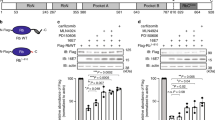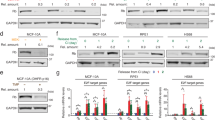Abstract
ORIGINALLY E2F sites were identified as elements in the promoters of adenovirus early genes that are necessary for activation of these genes by the early protein E1a (ref. 1). E2F promoter elements have been shown to be important for transcriptional activation of several genes critical for progression through the cell cycle2–4. During the G1 phase of the cell cycle, the E2F protein forms a complex with the cell-cycle protein Rb (ref. 5) and it has been suggested that this binding of Rb to E2F inactivates E2F (ref. 5). Here we show that Rb-E2F is an active complex that, when bound to the E2F site, inhibits the activity of other promoter elements and thus silences transcription. We propose that the ability of this complex to inhibit transcription is integral to the function of Rb and provide evidence that E2F is a positive element in the absence of an active form of Rb. It has been shown that binding of Rb to E2F depends on the phosphorylation state of Rb (only the underphosphorylated form binds)5 and that the phosphorylation state of Rb changes during progression through the cell cycle6,7. We therefore suggest that the E2F site alternates between a positive and negative element with the phosphorylation/dephosphorylation cycle of Rb. This cyclic activity may be responsible for activating and then inhibiting genes during the cell cycle.
This is a preview of subscription content, access via your institution
Access options
Subscribe to this journal
Receive 51 print issues and online access
$199.00 per year
only $3.90 per issue
Buy this article
- Purchase on Springer Link
- Instant access to full article PDF
Prices may be subject to local taxes which are calculated during checkout
Similar content being viewed by others
References
Kovesdi, I., Reichel, R. & Nevins, J. R. Proc. natn. Acad. Sci. U.S.A. 84, 2180–2184 (1987).
Blake, M. C. & Azizkhan, J. C. Molec. cell. Biol. 9, 4994–5002 (1989).
Thalmeier, K., Synovzik, H., Mertz, R., Winnacker, E. L. & Lipp, M. Genes Dev. 3, 527–536 (1989).
Mudryj, M., Hiebert, S. W. & Nevins, J. R. EMBO J. 9, 2179–2184 (1990).
Chellappan, S. P., Hiebert, S., Mudryi, M., Horowitz, J. M. & Nevins, J. R. Cell 65, 1053–1061 (1991).
Buchkovich, K., Duffy, L. A. & Harlow, E. Cell 58, 1097–1105 (1989).
Ludlow, J. W., Shon, J., Pipas, J. M., Livingston, D. M. & DeCaprio, J. A. Cell 60, 387–396 (1990).
Hearing, P. & Shenk, T. Cell 33, 695–703 (1983).
Hiebert, S. W., Blake, M., Azizkhan, J. & Nevins, J. R. J. Virol. 65, 3547–3552 (1991).
Bagchi, S., Raychaudhuri, P. & Nevins, J. R. Cell 62, 659–669 (1990).
Chittenden, T., Livingston, D. M. & Kaelin, W. G. Cell 65, 1073–1082 (1991).
Robbins, P. D., Horowitz, J. M. & Mulligan, R. C. Nature 346, 668–671 (1990).
Weintraub, S. J. & Dean, D. C. Molec. cell. Biol. 12, 512–517 (1992).
Yee, A. S., Reichel, R., Kovesdi, I. & Nevins, J. R. EMBO J. 6, 2061–2068 (1987).
Rosen, G. D., Birkenmeier, T. M. & Dean, D. C. Proc. natn. Acad. Sci. U.S.A. 88, 4094–4098 (1991).
Shew, J. Y. et al. Proc. natn. Acad. Sci. U.S.A. 87, 6–10 (1990).
Takahashi, R. et al. Proc. natn. Acad. Sci. U.S.A. 88, 5257–5261 (1991).
Scheffner, M., Munger, K., Byrne, J. C. & Howley, P. M. Proc. natn. Acad. Sci. U.S.A. 88, 5523–5527 (1991).
Bernards, R. et al. Proc. natn. Acad. Sci. U.S.A. 86, 6474–6478 (1989).
Whyte, P. et al. Nature 334, 124–129 (1988).
Author information
Authors and Affiliations
Rights and permissions
About this article
Cite this article
Weintraub, S., Prater, C. & Dean, D. Retinoblastoma protein switches the E2F site from positive to negative element. Nature 358, 259–261 (1992). https://doi.org/10.1038/358259a0
Received:
Accepted:
Published:
Issue Date:
DOI: https://doi.org/10.1038/358259a0
This article is cited by
-
The CDK4/6 inhibitor revolution — a game-changing era for breast cancer treatment
Nature Reviews Clinical Oncology (2024)
-
MYC induces CDK4/6 inhibitors resistance by promoting pRB1 degradation
Nature Communications (2024)
-
Targeting CDK4 and CDK6 in cancer
Nature Reviews Cancer (2022)
-
Retinoblastoma protein as an intrinsic BRD4 inhibitor modulates small molecule BET inhibitor sensitivity in cancer
Nature Communications (2022)
-
Cell cycle regulation: p53-p21-RB signaling
Cell Death & Differentiation (2022)
Comments
By submitting a comment you agree to abide by our Terms and Community Guidelines. If you find something abusive or that does not comply with our terms or guidelines please flag it as inappropriate.



